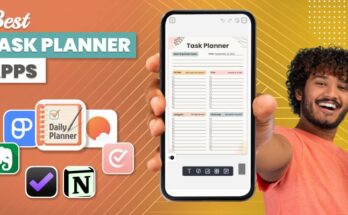As a student, managing assignments, deadlines, exams, and projects can quickly become overwhelming. Balancing classes, studying, and homework often leads to missed deadlines and confusion. Fortunately, a to-do list app for students can streamline the process, helping you stay organized and on top of your tasks. In this post, we’ll explore how students can effectively use a to-do list app to reduce stress, stay organized, and efficiently manage their academic workload.
Key Benefits of Using a To-Do List App for Students
The to-do list application serves as a vital technological tool that helps users handle their assignments along with their workload and boost their academic output. The apps provide essential features that enable users to establish priorities schedule deadlines and monitor their advancement making it simpler to handle assignments together with tests and projects. Reading about the main advantages a to-do list app brings to improve academic achievement and lower stress levels.
- Improved Time Management: Students improve their time management through a to-do list app because these tools enable detailed assignment scheduling along with logical distribution of work into smaller segments. Deadlines and task breakdown tracking through these apps help students prevent procrastination while maintaining efficient workload management by incorporating time management tips, which provide enough time for their entire academic workload.
- Better Task Organization: The structure provided by category organization, task prioritization, due date features, and reminder functions enables students to manage their tasks through to-do list apps. The tool helps people track crucial deadlines and focus on essential assignments while lowering the potential to miss vital work due dates or tests.
- Increased Productivity: Students benefit from to-do list apps that break complex tasks into smaller tasks and establish clear priorities so they can perform one assignment at a time. Using this method helps students avoid intense pressure while it makes their work process more efficient which ultimately speeds up their assignments and creates surplus time.
- Reduced Stress: When tasks and deadlines are displayed visually the stress decreases because such organization gives students both control and provides peace of mind about upcoming responsibilities. Students can stop worrying about missing important tasks since task tracking combined with reminder systems helps them meet deadlines thus reducing their work-related anxiety.
- Accessibility Across Devices: The majority of to-do list applications offer device synchronization which enables students to view their tasks through any combination of their phone tablet and personal computer. The effortless application access allows students to stay productive while outside of classroom spaces thus simplifying their task management between academic sessions and free time.
Navigate Academic Tasks with a To-Do List App for Students
Students find academic task control to be highly challenging. The to-do list app simplifies the organizational management of academic assignments exams and projects. Students benefit from using such an app to organize their work while setting priority levels and tracking their various deadlines which leads to better productivity reduced stress and better focus on essential academic objectives.
Download and Set Up the App
The process starts by downloading PlanWiz through an app store while simultaneously creating an account. Students can use PlanWiz to access organized features that simplify the management of their responsibilities and assignments. Users should personalize the app through theme selection and remind themselves by scheduling upcoming deadline alerts.
Get Organized with PlanWiz To Do List App
Plan your days efficiently with our feature-rich app, available on both Android and iOS devices.

PlanWiz enables students to use multiple to-do list planner templates that enhance their capacity to arrange their assignments and projects along with exams in systematic ways. The cross-device synchronization feature of this platform ensures you won’t overlook crucial assignments which keeps you efficient and systematic from beginning to end of your academic year.
Create Categories for Your Academic Tasks
To make category creation even easier, check out our pre-designed academic task planner templates that come with built-in categories for students. The creation of different categories in your to-do list app allows you to remain organized while effectively managing academic work, including assignments, along with exams, to avoid any missed responsibilities. This guide demonstrates the process of dividing tasks into particular categories.

- Assignments: This category includes tasks related to homework, projects, and essays that need to be completed and submitted by specific deadlines.
- Exams: Organize preparation tasks for upcoming exams, quizzes, or tests. This could include studying, reviewing notes, or completing practice questions.
- Lectures: Keep track of lecture-related tasks such as attending classes, reviewing lecture notes, or completing any related assignments or discussions.
- Readings: Stay on top of the required readings for each course. This category ensures you don’t fall behind in your coursework.
- Meetings: Add tasks related to meetings such as office hours, study group sessions, or group project discussions.
Add All Your Academic Tasks
Once you create your categories the next step is to insert all academic tasks into the application as you want to maintain total visibility of your workloads. For example:
- Math Assignment Due Feb 10
- History Essay Due Feb 15
- Prepare for Biology Midterm on Feb 20
Larger assignments including essays and examination preparation require separation into smaller operational components for better management. You can monitor your advancement better while avoiding overwhelming situations by implementing this system. The subtasks for a History Essay should include:
- Research Topic
- Write Outline
- Draft Essay
- Proofread and Edit
The process of transforming large assignments into multiple sections enables students to concentrate on single portions thus stopping procrastination while creating accessibility to handle the workload better. The strategy maintains your organizational structure and supports steady academic work toward accomplishing large assignments.
Set Priorities and Deadlines for Each Task
After adding all your academic tasks to the app users should prioritize them while setting time constraints for completion. You can focus on essential work by prioritizing activities while deadlines provide necessary tracking for goal achievement. Follow this method to establish your academic task priorities:
- High Priority: These are tasks that require immediate attention or are due soon. For example:
- Finish Math Assignment (Due Tomorrow)
- Study for History Test (Test Next Week)
These tasks should be completed as soon as possible to avoid unnecessary stress or last-minute cramming.
- Medium Priority: These are important tasks, but not urgent. For example:
- Work on Research Paper
- Start studying for the Midterm Exam
While not due immediately, these tasks should be worked on steadily over time to ensure that you’re prepared in advance.
- Low Priority: These tasks can wait or are less urgent. For example:
- Organize Lecture Notes
- Check Course Materials for Next Week
These tasks should be completed when you have extra time or when more urgent tasks are finished.
Setting due dates should accompany priority assignments for every task. The addition of reminders proves helpful for avoiding missed deadlines because it provides you with enough time to finish work with efficiency. You can control your workload better as well as minimize critical task failures when you establish proper timeframes and organizational priorities.
Plan Your Daily and Weekly Schedule
Your next task should be creating a daily and weekly schedule following your work task setup and prioritization. With proper organization of your workload, you can maintain daily efficiency and effective productivity in your work. Proper time organization, including ways to organize study and personal life, follows these steps:

Daily Tasks: Each morning you need to examine your daily tasks and then pick out several items for priority work. The method allows you to maintain your focus while preventing a feeling of being overwhelmed. You should choose several tasks on any particular day for accomplishment.
- Finish the History Essay Introduction
- Review Biology Lecture Notes
- Work on Math Assignment
By focusing on a few tasks each day, you’ll avoid spreading yourself too thin and increase your productivity.
Weekly Overview: Devote a short time early in the week to design bigger projects along with your goals for the upcoming period. The system consists of projects together with long-term assignments as well as examination preparation. For example:
- Monday: Write a History Essay Outline
- Tuesday: Study for Midterm Exam (2 hours)
- Wednesday: Submit Math Assignment
- Friday: Review Notes for Biology Test
A weekly plan enables you to see all your responsibilities thus maintaining organization while boosting motivation. The weekly plan functions as a path to success which protects you from sudden chaotic work completion in the final hours.
Break Large Tasks into Actionable Steps
Every student faces overwhelming feelings concerning large assignments when they have numerous examinations and projects simultaneously. Using a to-do list app will help you alleviate stress by converting big assignments into simpler manageable tasks. When dealing with large tasks follow this strategy.
History Essay: Instead of leaving the entire essay as one big task, break it down into smaller, actionable subtasks:
- Research Essay Topic
- Write the First Draft
- Edit and Proofread
This approach makes the process feel less overwhelming and helps you track your progress step by step.
Exam Preparation: Similarly, when studying for exams, divide your study sessions into manageable chunks:
- Review Lecture 1
- Review Lecture 2
- Create Study Notes
Breaking down studying into smaller sections helps you focus on one part at a time, increasing your chances of retaining information and staying organized.
Stay Flexible and Adjust Plans When Needed
Being flexible enables students to handle their academic work successfully. The to-do list application enables users to change their plans instantly when tasks require additional time or new deadlines emerge. A to-do list app helps users keep track of tasks through effortless rearrangement which prevents feelings of being overwhelmed. Your ability to adapt matches your ability to handle unexpected challenges without compromising academic control over your duties.
You will maintain readiness for unexpected situations when you reassess your priorities. Assign high-priority status to urgent jobs followed by deadline readjustments to prevent delays. Your schedule’s unpredictability cannot affect your organization or control because of flexibility. Using this approach decreases your stress levels while maintaining your focus on your objectives.
How Students Can Overcome Procrastination with a To-Do List App
Educational tasks face significant barriers from the student behavior of procrastination. The right to-do list application can assist students in managing their procrastination while they develop a system to tackle their assignments and studies. The to-do list app assists students in maintaining their focus by reorganizing tasks and using reminders which simplifies projects through step-by-step subdivisions to help achieve deadlines without added pressure.
- Set Realistic Deadlines & Priorities
- Mark tasks as High Priority, Medium Priority, or Low Priority.
- Assign specific due dates for each task to create a sense of urgency.
- Use Reminders to Stay on Track
- Set daily reminders to stay focused on tasks.
- Schedule multiple reminders (e.g., an hour before a deadline) to avoid last-minute panic.
- Track Your Progress
- Mark completed tasks as “done” to see your progress in real time.
- The satisfaction of checking off tasks motivates continued productivity.
- Apply the “Two-Minute Rule”
- For tasks that take less than two minutes, do them right away.
- Helps clear small tasks from your list, reducing mental clutter.
- Use the Pomodoro Technique
- Work in 25-minute intervals, followed by 5-minute breaks.
- To-do list apps with timers can help you stick to the technique, preventing distractions.
- Hold Yourself Accountable
- Share your to-do list with friends or study partners to stay accountable.
- Use streaks, goals, or progress trackers within the app to motivate consistency.
- Reward Yourself for Completing Tasks
- Reward yourself after completing tasks (e.g., take a break, treat yourself).
- Positive reinforcement encourages a productive mindset.
Conclusion
Managing your academic tasks doesn’t have to be stressful. With a to-do list app, you can stay organized, prioritize tasks, and track progress effortlessly. Breaking down larger tasks, setting reminders, and planning your day helps you stay on top of everything. Start using a to-do list app today to take control of your workload stay productive, reduce stress, and enjoy a more efficient and organized study routine!








